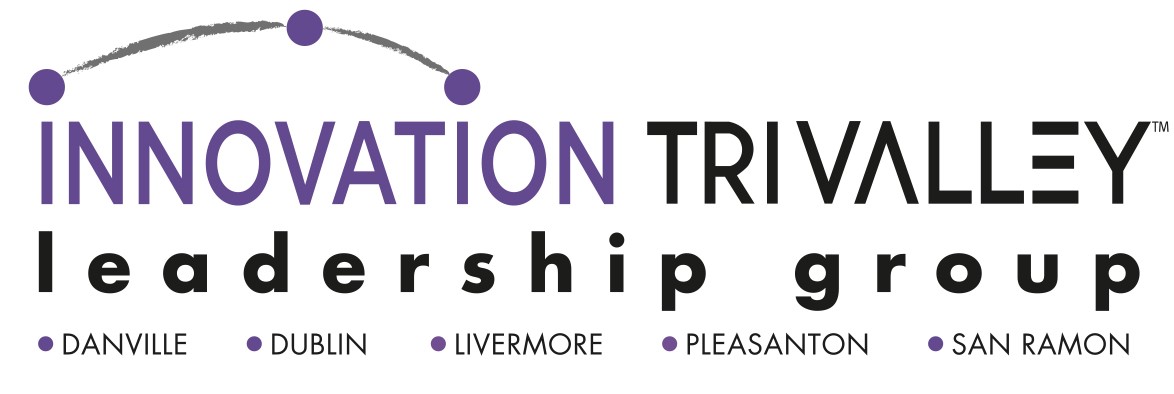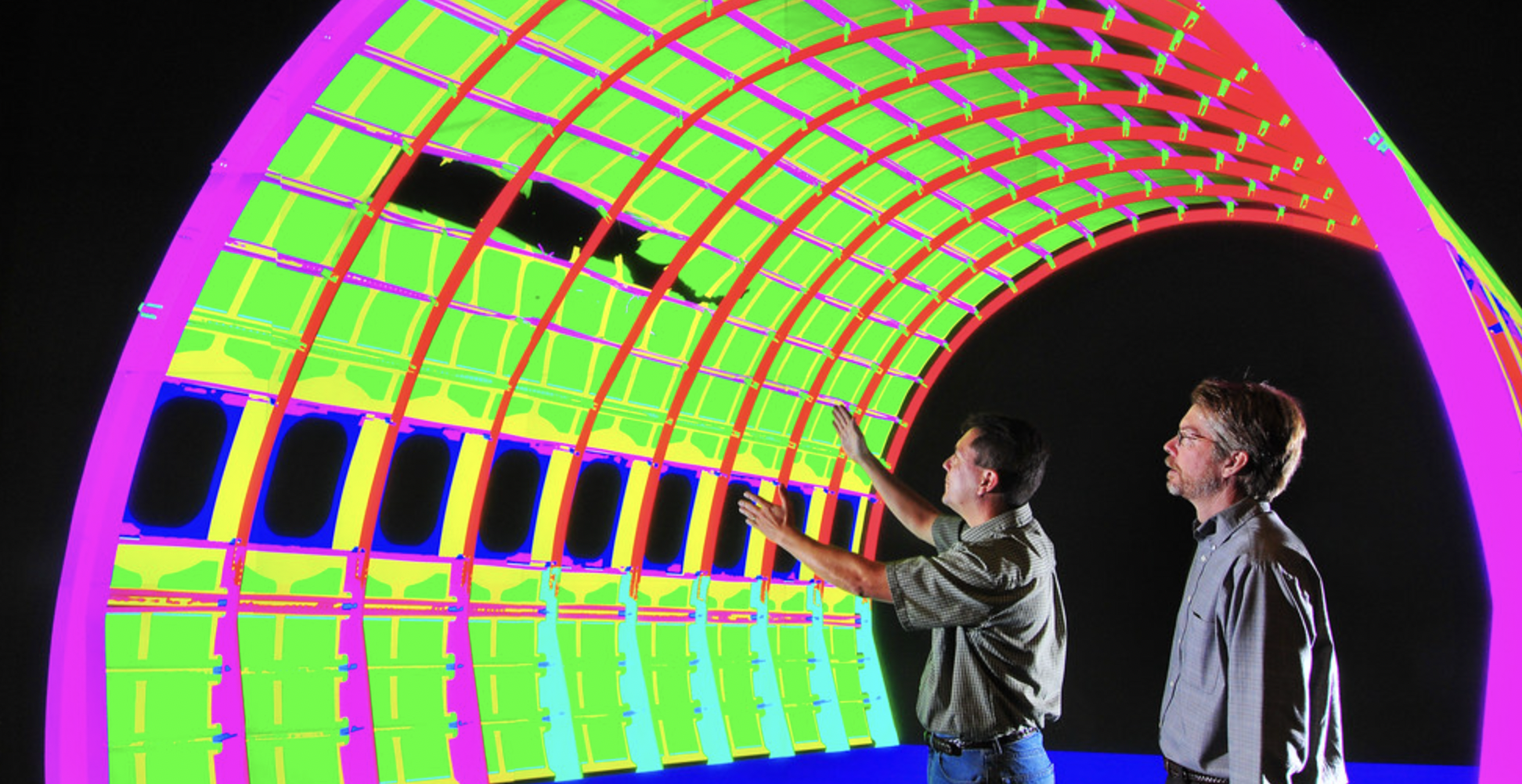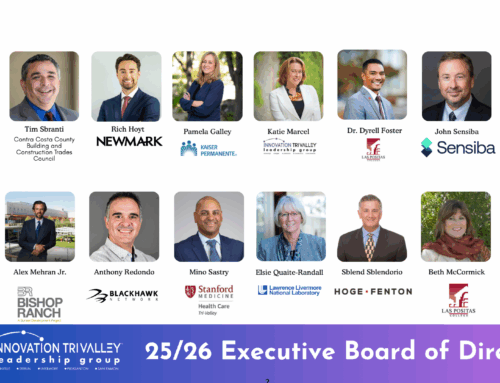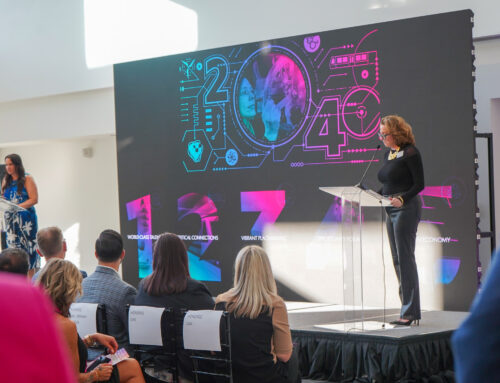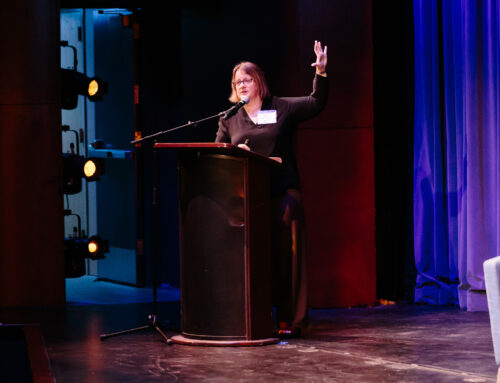From Livermore Vine | July 15, 2022 |by Tim Hunt
Celebrating its 10th anniversary, the Innovation Tri-Valley Leadership Group has set an ambitious agenda for moving forward.
Last year, despite the adversity created by the COVID-19 driven shutdowns and restrictions, the group released its Vision 2040.
Working collaboratively with the Bay Area Council’s Economic Institute, the project engaged more than 1,000 people to gather their input and comments on what’s important for the Tri-Valley to maintain its enviable quality of life and economic vitality 20 years from now.
In a 2018 report, “Tri-Valley Rising,” the five cities in two counties produced an economic impact of $42 billion, equivalent to that of North Carolina’s research triangle. Given the explosive growth of Tri-Valley companies over the last five years, that number likely has soared.
So have the challenges laid out in the Vision 2040. It’s an aspirational document, shaped in five areas — to move forward for 20 years. These priorities, the report states are not specific road maps, but instead destinations with a variety of routes available to get there. They are:
* Globally recognized innovation: With two national labs, 450 technology companies, the goal is to build on these so the Tri-Valley is recognized worldwide for its innovation.
* Equity and inclusion focused: The economic success over the last decades is obvious; the report states that the leaders here seek intentionally to produce more equitable opportunities and outcomes for all local workers and residents.
* Connections and collaborations: Public-private partnerships that “break down silos” can develop solutions at scale according to the report. The Tri-Valley already collaborates in industry and government across city lines and county lines.
* Balanced and diverse lifestyle: Leaders want the quality of life here to be accessible to all and that will require balancing the strengths of the current suburban neighborhoods with vibrant downtowns while maintaining agriculture, open space, and hiking and biking trails.
* Epicenter of solutions: Tri-Valley communities have taken the lead in developing regional solutions while not waiting for other levels of government to “dictate” its future. The report lays out why it’s important to maintain and expand this commitment.

Industry and community leaders take part in one of the original Vision 2040 stakeholder planning sessions. Photo courtesy Innovation Tri-Valley
Newell Arnerich, a 27-year town councilman in Danville, wrote, “Public-private partnerships are often talked about and in the case of Innovation Tri-Valley Leadership, this partnership with the five Tri-Valley cities and two counties, has demonstrated success at the highest level. Some groups follow with support and others, like ITV, lead the way though impacting government to open its doors and welcome new businesses while helping existing businesses grow.”
“Over the past 10 years, ITV has raised awareness of a quiet region with many hidden assets such as two national laboratories and a population where 60% of its residents have a bachelor’s degree or higher. ITV’s role in our regional is solely responsible for the regional and global success of the Tri-Valley in startup funding and capital investment creating a ‘Silicon Valley’ east,” Arnerich added.
Steve Lanza, the second chairman of Innovation Tri-Valley, drove the project along with CEO Lynn Wallace Naylor. Building on the prior work, the group knew the Tri-Valley already has a strong innovation ecosystem.
Entrepreneurs, both experienced and first-timers, have chosen to build companies here. The area has a robust transportation infrastructure with interstates 580 and 680 intersecting as well as two BART stations and ACE rail stations. Knitting those together with the Valley Link project that will connect the eastern Dublin-Pleasanton BART Station with stations in San Joaquin County using former railroad right-of-way owned by Alameda County.
Compared to Silicon Valley, the Peninsula and San Francisco, the Tri-Valley’s housing stock is newer and less expensive. During the pandemic, it was particularly desirable because of the many single-family home neighborhoods with backyards.
For companies based here recruiting throughout the Bay Area, it becomes an opportunity for a highly skilled employee to buy a home or enjoy a relatively easy counter commute, whether driving or riding BART. And that’s not accounting for working remotely.

Advancements in supercomputing technology at Sandia National Laboratories in Livermore are the sort of innovative work that the Vision 2040 strives to support. Photo courtesy Sandia
The area also has a very well-educated workforce in place. About 26% of Tri-Valley residents hold an advanced degree, while more than 60% have a bachelor’s degree. Twenty years ago, when the Tri-Valley Business Council released its Golden Valley Vision 2010, about one-third of residents held a bachelor’s degree. That speaks to the shift in the caliber of the workforce.
It’s been anchored for more than 70 years by the national laboratories in East Livermore, Lawrence Livermore and Sandia. Both are growing their work forces as they expand their roles in national security and other cutting-edge research. Both have spawned multiple local companies using technology and research licensed from the labs. And there’s been a strengthened commitment in the last decade to transfer more technology with the Open Campus.
During a tour of the then-new Advanced Manufacturing Research Lab, Rich Rankin — the late head of Lawrence Livermore’s technology transfer — emphasized that they were seeking partnerships with companies using the facilities, expecting to learn from them.
That attitude has been prevalent at engineering-driven Sandia since it opened the combustion research center in the early 1990s.
The Open Campus and the collaborations coming out of it such as the DaySpring Innovation Center in Livermore and the Tri-Valley Life Sciences Summit. DaySpring is moving this summer into its third Livermore location after starting downtown as i-Gate Innovation Hub, a nonprofit in 2014 co-founded by the national labs and the cities. It offers lab space to deep tech and life science startups.
In contrast to other areas that have seen an exodus of tech companies, ITV reported that the number of tech firms locally grew by 60% over the last four years. In 2020, local companies received $473 million in venture funding according to the East Bay Economic Alliance for Business.

Rick Shumway, ITV board chair and CEO/president of Stanford-ValleyCare, addresses the audience at #Gamechangers2022. Photo by Lisa Chow Photography
Given 24 “destinations” in the report, prioritizing becomes a key challenge. Some will take years if not decades, while others are more attainable.
Naylor, Lanza and current chair Rick Shumway, CEO of Stanford Health Care-ValleyCare, all identified the same key strength for the group — determining the issue, deciding who needs to be around the table to start working it and then bringing them together. Shumway noted that all are priorities so the organization will be “sequencing” the areas with focus on some sooner while others may be five years out.
Supervisor David Haubert, who previously served as Dublin mayor and school trustee, wrote in an email, “The value of ITV is the regional perspective they bring, pulling together the whole Tri-Valley. ITV is especially helpful in the work their committees do to support regional policy-making. Their HIT committee, Housing Infrastructure and Transportation, for example, is a strong advocate for regional projects.”
The ITV leadership already witnessed the launch of one of its goals — a local community foundation. A group of leaders cross-pollinated with ITV including its first chairman John Sensiba, launched the Three Valleys Community Foundation last year after detailed and careful preparatory work. It’s now engaged in raising seed money with retired Pleasanton City Manager Nelson Fialho serving as interim executive director. In August, newly retired Livermore school superintendent Kelly Bowers will move into the CEO/president role.
The other initial focus areas included:
* Pioneering new housing with walkable, affordable communities. Sunset Development Co. in Bishop Ranch is leading the way by transforming surface parking lots into 4,500 high-density units surrounded by office buildings. It redeveloped decades-only two-story office buildings into its showcase City Center with retail, restaurants and entertainment. Developers have built high-density projects at BART stations in Dublin and Pleasanton, but they lack the retail to be truly walkable.
* Plan for new tech/light industrial park innovation zone. Given the premium value now placed on industrial land in the Tri-Valley, identifying and setting aside a large parcel will be a challenge. Veteran commercial broker Mark Triska said that developers are now willing to pay per-square-foot prices for industrial land close to what residential developers will pay in the mid-$30s. “For a whole industrial park zone, it’s going to take work,” Lanza said.
* Solve the digital divide. This will take innovation and collaborative solutions because students in poorer areas in Pleasanton and Livermore showed during the pandemic what a challenge this was during remote learning. Las Positas College saw students driving to its parking lots and sitting in their cars to tie into high-speed broadband.
* Embracing the region’s health care system as key strengths. The Bay Area’s renowned teaching hospitals — Stanford and the University of California San Francisco — both have affiliates or partners in the valley; ValleyCare for Stanford and John Muir for UCSF. The Sutter Medical Foundation also has a facility in Dublin while Kaiser Permanente has a major new urgent care and cancer treatment facility in Dublin as well as medical offices in Pleasanton, San Ramon and Livermore.
Moving forward, ITV has a strong group of business leaders who are committed to driving the vision. The group has influence through its membership, but all the decision-making lies in various government agencies.
When asked about this, Naylor said, “What we do have is strength, tenacity and ingenuity. We will continue to be out in the community inspiring people. People are calling us after seeing the video about Vision 2040 and saying they want to contribute.”
Chair Shumway said, “What I love about ITV is it’s pretty action-oriented. We have a vision and it’s not just our vision — it’s the collective vision that we brought many people together to formulate. And now, what do we do to get it done. One of the reasons I think ITV can be influential is the relationships we have with the people that make us up.”
It’s a time of transition for valley leadership with new city managers in Livermore and Pleasanton, a new school superintendent in Livermore, an interim leader at the winegrowers association and an interim leader at the Tri-Valley Conservancy. Some newly appointed are in-house, Livermore schools chief Chris Van Schaack and Gerry Beaudin at Pleasanton (albeit with a three-year stint at Alameda in between), while others are new to the area. It provides the opportunity for ITV’s leaders to share the Vision 2040 and how the various agencies can be part of it and benefit from it.
One area that ITV members want to move forward is tying educational certificate programs directly to job opportunities at major employers — giving students pathways that do not require four-year degrees.
“There’s huge momentum around that,” Naylor said. “Collaborations that get kids into the workforce faster. I think we’ll have real influence there by being the convener and bringing the right people to the table.”
Arnerich wrote, “Changing local government’s attitude from ‘What do you want?’ to ‘How can I help you succeed?’ was a pivotal foundational change in our region. Each city has a unique offering of support and assets but all share a common value around ITV’s drive to unify the region as the best place to do business.”
“Since ITV’s creation over a decade ago, the Tri-Valley has truly risen to be the most advanced business friendly region with success stories in every pocket of the area,” he added. “Our communities have truly become more robust and diverse communities both culturally and economically because of ITV’s leadership role in celebrating our collective assets. ITV supports education at K-12 and community college levels to align curriculum with the region’s needs in job growth and creation.”

Lawrence Livermore National Laboratory co-author Caitlyn Krikorian Cook, a group leader and polymer engineer in the lab’s Materials Engineering Division, characterized the curing kinetics of the nanocomposite silica glass resin with light exposure. Photo by Garry McLeod/LLNL
The Tri-Valley demographics have shifted dramatically in the last decade with well-educated, well-compensated newcomers moving here, and many first-generation immigrants from elsewhere. Shumway related how the CEO of Iris Vision, originally from Pakistan, told him how comfortable he and his family were here because of the diversity.
When asked about how he would convince elected officials and other citizens about the need for housing, Shumway related the story about a key employee in the ValleyCare heart catheter lab. His wife was expecting their first child and they were working hard to buy a home in Livermore. They could not pull it off and now his future here — as a skilled employee — is up in the air.
For people living further out and paying $6-7 a gallon for gasoline right now, how viable is it to work in Pleasanton, particularly before the ValleyLink trains get running that are several years out? That’s why a range of housing options is so important as is increasing supply.
ITV certainly has plenty of work and convening in front of it, but the leaders are optimistic they can move the plan forward.
Naylor said, “There are five reasons people are attracted to the Tri-Valley, but the most important one is quality of life. This is the place where leaders and innovators want to live and that has to be protected. That’s why this plan is important because the balance of innovation and quality of life has to exist. It always has in the core values here and that will never go away.”
The plan is about maintaining and enhancing that core value.

Ceremonial ribbon-cutting on June 15 marks the completion of the National Nuclear Security Administration and Lawrence Livermore National Laboratory Exascale Computing Facility project. The utility-grade infrastructure project massively upgraded the power and water-cooling capacity of the adjacent Livermore Computing Center. . Photo by Julie Russell/LLNL
Originally posted here https://www.livermorevine.com/other-news/supporting-local-innovation-5587000
